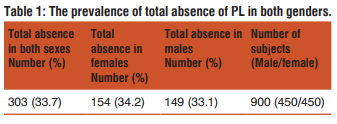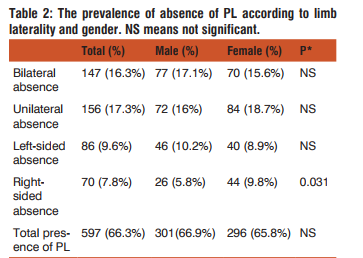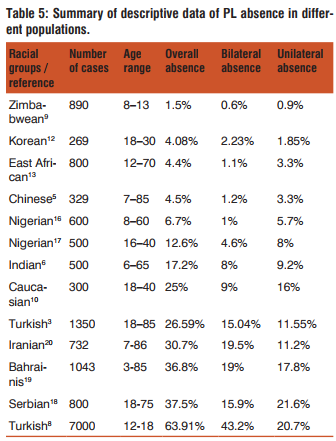IJCRR - 7(14), July, 2015
Pages: 45-48
Print Article
Download XML Download PDF
THE PREVALENCE OF PALMARIS LONGUS ABSENCE IN THE CITY OF KERMAN IN IRAN AND THE RELEVANCE OF AGE, GENDER AND BODY SIDE
Author: Babaee Abdolreza, Dehghani Soltani Samere, Ansari Javad Mohajer, Eftekhar Vaghefi Seyed Hasan, Ezzatabadipour Massood
Category: Healthcare
Abstract:Background: Phylogenetic agenesis, comparative anatomy and clinical importance of palmaris longus (PL) as a vestigial muscle have been considered by anthropometric studies. Objectives: Determination of the prevalence of absence of this muscle in the city of Kerman in Iran and possible relevance of sex and the left or right sides were the main goals of present study. Methods: In total, 900 individuals, 14\?50 years old, from the city of Kerman in Iran whocould take advantage of the standard Schaeffer's test were studied. Results: The overall PL absence in both sexes was 33.7%. The frequency of bilateral absence of PL was not significant in both genders. Our findings showed a markedly higher right-sided PL agenesis in females (9.8%) than in males (5.8%). Additionally, this data demonstrated a higher left-sided absence of PL in the young group than in the middle-aged group which was statically significant (p=0.001). Conclusion: The total prevalence of PL agenesis was higher in comparison with reported data in literature and textbooks. Findings of the present study indicated that the prevalence of PL absence is significantly different to other regions and findings in textbooks. These results are important as phylogenetic and clinical issues.
Keywords: Human, Palmaris iongus muscle, Agenesis, Phylogenetic, Anthropometry
Full Text:
INTRODUCTION
The palmaris longus (PL) is one of the superficial flexor muscles of the forearm. It has a short fusiform bellyand long cord-like tendon. Its tendon is a useful indicator ofthe anatomical position of the median nerve in surface anatomy. Although variability in the muscles is low, PL variation is relatively high, such as in double muscles, anomalous attachments and the existence of a distal belly. The latter instance can produce symptoms of carpal tunnel syndrome by compressing the median nerve.1, 2 However, the most common variation of this muscle is PL agenesis.3 The attention of anthropometric and clinical studies has been attracted to phylogenetic agenesis of PL for the following reasons: one of them is PL’s weakened performance in human bipedal locomotion in comparison with quadrupedal mammals and the other is its tendon usage in reconstructive surgery such as cruciate ligament replacement in the knee, upper eyelid ptosis correction and chin reconstruction.4 Absence of PL was reported for the first time by Columbus in 1559.5 PL absence in the entire population is about 13– 15% 6, 7 but significant differently data has been reported in different regions and for different racial groups: from 1.5% for Zimbabwean to 63.9% for the Turkish population.8, 9 The relationship between PL absence and factors like region, race and sex maybe the reason forthe different data presented.10 Is unilateral absence of PL (left or right sided) related to these factors? Therefore, determination of prevalence of unilateral or bilateral PL absence and its relation with gender, age and right or left side of the body in the city of Kerman of Iran were the aims of this study.
MATERIALS AND METHODS
To accomplish this research, 900 individuals who lived in the city of Kerman in Iran were randomly selected and their upper limb extremities were examined. The sample population included 450 healthy males and 450 females (age: 14 to 50; mean±standard deviation: 23.66±6.80). Existence or absence (unilateral and bilateral) of the PL tendon was assessed by taking advantage of a standard test (Schaeffer’s test). On the basis of this test, the opposition of the thumb and little finger and then flexion of wrist (about 20 degrees) distinguishedthe tendon of the PL on the front of the distal part of the forearm.3 If the tendon of the PL was not satisfactorily palpable by standard test, three additional tests (Thompson’s fist test, Mishra test and Pushpakumar’s “two-finger sign”method) were carried out to determine PL absence.5 In addition, the age and sex of each person were recorded. The subjects of this study were divided into two groups: (1) young (aged 14–28) and (2) middle-aged (aged 29–50). Statistical analysis was done by SPSS software (version 16). The prevalence of agenesis of PL was presented with a 95% confidence interval and the association between PL agenesis and age groups and gender analyzed using the chi-square test. Differences were considered significant at p <0.05.
RESULTS
The total prevalence of PL absence was 33.7% (303 subjects) (Table 1).

The PL was absent bilaterally in 147 subjects (16.3%) and unilaterally in 156 subjects (17.3%); left- and right-side absence values respectively were 86 (9.6%) and 70 subjects (7.8%) irrespective of gender. The prevalence of bilateral absence of PL was not significant between the two sexes, but right-sided PL absence was significantly higher in females (9.8%) than males (5.8%, p= 0.031) and there was a markedly higher absence of PL on the left side (10.2%) in comparison with the right side (5.8%) of the body in males (p=0.018) (Table 2).

A comparison of PL absence between two age groups (Table 3) showed a higher left-side absence of this muscle in the young group (10.5%) than in the middle-aged group (5.4%) that was statically significant (p=0.001), but there was no statistical difference in prevalence of bilateral agenesis betweenthe two groups (Table 4).

DISCUSSION
The PL muscle is found only in mammals and its development and action are more powerful in species that used the forelimbs as weight-bearing organs (quadrupeds).6 In the process of evolution, the usage of the forelimbs gradually changed in the higher primates and then, the PL muscle’s belly lost its size while the length of the tendon seems to have increased from primitive primates to more developed ones. Therefore, the PL became weaker in modern humans and, based on anthropometric studies, was found to tend to be missing.11 But the understanding of the phylogenetic elimination rate of PL agenesis between different races and regions requires more investigation and comparison. A brief comparison of our results with previous studies indicated that the total prevalence of PL agenesis in Kerman (33.7%) was significantly higher than results among Chinese, 4.5%5 , Korean, 4.08%12, Zimbabwean, 1.5%9 and East African, 4.4%13 populations. It was also higher than in two studies in India (17.2 to 27.4%)6, 14, 15 and two studies in the Nigerian population (6.7 and 12.6%).16, 17The results reported by Koseand colleagues (Turkish, 26.6%) and Thompson and colleagues (Caucasian, 25%) also are lower than our results.3, 10 However, four studies in Turkey (63.9%, Gazientep population), Jordan (38.6%), Serbia (37.5%) and Bahrain (36.8%) found a higher prevalence of PL absence than in our results.8, 18, 19 In addition, our results were higher than results of other Iranian studies (from 22.8 to 30.7%).20, 21The descriptive data of PL agenesis in different countries is summarized in Table 5.

In brief, significant results of the present study in comparison with other regions indicate a relatively higher percentage of PL absence in Kerman than in literature data. Other than the Serbian results the greatest reported amounts were found in the regions near Iran (Turkish, Bahrainian and Indian populations). Minute assessment of these differences points to genetic and environmental factors that may be creative elements alongside phylogenetic factors, although it seems that the influence of environmental factors is stronger. In other words, in terms of the influence of environmental factors, the elimination rate of this muscle among different regions and races is different. But, assessment of unilateral and bilateral PL absence data indicates that the influence of environmental factors on individual genetics may be not equal. Genetic factors that control this phenomenon have not been reported yet. The relationships between PL absence and other anatomical anomalies such as anomalous superficial palmar arch, absence of flexor digitorum superficialis, absence of the plantaris muscle, etc. were reported.5, 9 Although the results of the present study showed female PL absence was more frequent than in males (34.2% vs. 33.1%) this difference is not significant and this issue is similar to three studies in Nigeria, China and Korea.5, 12, 17 Nevertheless, other studies, such as in Turkey [3], Bahrain19, India6 and one in Iran20 reported that PL absence were more common in females. With regard to these contradictory results, more investigations are required. Although our findings demonstrated significant right-side PL absence in females and left-side PL absence in males, these results are not consistent with the results of KarimiJashniand colleagues who reported higher left-side absence in females than in males.20 Results of bilateral absence of PL in the present study also indicate a relatively high percentage (16.3%). Although there are some differences between male and female bilateral absence of PL data (17.1% vs. 15.6%, respectively), these differences are not significant. The evidence was not adequate to involve sex chromosomes and other factors in PL agenesis. The relation between absence of PL and body side has been the subject of numerous previous studies. Our study showed a higher absence of the PL on the left side (10.2% vs. 5.8%) in males (p=0.018) and right side (9.8% vs. 5.8%) in females (p= 0.031), which is similar to the results from Kapoor and colleague’s study6 but is in contrast with results from the Serbian population where the difference between body sides was not significant.18 The present study demonstrated that the left-side absence of PL was markedly higher in young people (10.5%) in comparison with middle-aged people (5.4%).This result is similar to that in Jashni’s study which showed that the prevalence of PL agenesis was significant in terms of age groups1 but in contrast to results from Eric and colleagues that reported no significant difference in absence of this muscle in three age groups (young, middle-aged and old)18. These results indicate the increase of phylogenetic elimination of PL agenesis between these regions; perhaps it would be better if this comparison were to be conducted in other regions.
CONCLUSION
The total prevalence of PL agenesis in the city of Kerman in Iran was higher in comparison with reported data in literature and textbooks. Genetic and environmental elements as well as phylogenetic and sex factors may influence the PL agenesis rate.
ACKNOWLEDGMENT
The authors are deeply indebted to all participants for allowing us to conduct this research. We are also grateful to authors of all articles, journals and books are cited and included in references of this manuscript. Our work is supported in part by the Physiological Research Center of Kerman University of Medical Sciences.
References:
1. Jashni HK, Rahmanian K, and Jahromi AS.Relation of Palmaris Longus agenesis with hand dominance.Life Sci J 2014;11(2).
2. Backhouse K and Churchill-Davidson D.Anomalous palmaris longus muscle producing carpal tunnel-like compression. The Hand 1975;7(1): p. 22-24
. 3. Kose O, et al. The prevalence of absence of the palmaris longus: a study in Turkish population. Arch Orthop Trauma Surg 2009;129(5): p. 609-611
. 4. Foucher G, et al. Primary palmaris longus transfer as an opponensplasty in carpal tunnel release. The J Hand Surg: British and European Volume 1991;16(1): p. 56-60
. 5. Sebastin SJ, Lim AY and H. Wong, Clinical assessment of absence of the palmaris longus and its association with other anatomical anomalies-a Chinese population study.Ann Acad Med, Singapore 2006;35(4): p. 249.
6. Kapoor SK, et al. Clinical relevance of palmaris longus agenesis: common anatomical aberration.Anat Sci Int 2008;83(1): p. 45-48.
7. Sinnatamby CS, ed. Last`s Anatomy (regional and Applied). Tenth ed. 1999; Timothy Horne (for Churcill Livingstone). 63.
8. Ceyhan CAM, Distribution of agenesis of palmaris longus muscle in 12 to 18 years old age groups. Indian J Med Sci 1997;51(5): p. 156-160.
9. Gangata H. The clinical surface anatomy anomalies of the palmaris longus muscle in the Black African population of Zimbabwe and a proposed new testing technique.Clin Anat 2009;22(2): p. 230-235.
10. Thompson N, Mockford B, and Cran G.Absence of the palmaris longus muscle: a population study.Ulster MedJ 2001;70(1): p. 22.
11. Aversi-Ferreira RA, et al. Morphometric and Statistical Analysis of the Palmaris Longus Muscle in Human and NonHuman Primates. BioMed Res Int.2014; URL: http: // dx.doi. org/10.1115/2014/178906 (accessed, September, 2014).
12. Kyung DS, et al. Different frequency of the absence of the palmaris longus according to assessment methods in a Korean population.Anat Cell Biol 2012;45(1): p. 53-56.
13. Kigera JW and Mukwaya S.Frequency of Agenesis Palmaris Longus through Clinical Examination-An East African Study. PloS one 2011;6(12): p. e28997.
14. Sadeu JC, et al. Alcohol, drugs, caffeine, tobacco, and environmental contaminant exposure: Reproductive health consequences and clinical implications.Crit Rev Toxicol 2010;40(7): p. 633- 652.
15. Tejaswi HLSYD. Clinical Assessment of Agenesis of Palmaris Longus and Flexor Digitorum Superficial is in Indian Population. Int JRecent Trends in Sci Technol 2014;10(3): p. 492-494.
16. Mbaka GO, and Ejiwunmi AB.Prevalence of palmaris longus absence–a study in the Yoruba population. Ulster Med J 2009;78(2): p. 90.
17. Enye L, Saalu L, and Osinubi A, The prevalence of agenesis of Palmaris longus muscle amongst students in two Lagos-Based Medical schools. Int. J. Morphol 2010;28(3): p. 849-54.
18. Eri? M, et al. Prevalence of the palmaris longus through clinical evaluation. Surg Radiol Anat 2010;32(4): p. 357-361.
19. Sater MS, Dharap AS, and Abu-Hijleh MF.The prevalence of absence of the palmaris longus muscle in the Bahraini population. Clin Anat 2010;23(8): p. 956-961.
20. Karimi-Jashni HKR, and Jahromi AS, AGENESIS OF PALMARIS LONGUS IN SOUTHERN OF IRAN: A POPULATION BASED STUDY. OnLine J Biol Sci 2013;14(1): p. 8.
21. Keyghobad Ashoori M, and Dahmardehei M.Prevalence of Palmaris Longus Agenesis in a Hospital in Iran. Arch Iranian Med 2013;16(3): p. 187.
|






 This work is licensed under a Creative Commons Attribution-NonCommercial 4.0 International License
This work is licensed under a Creative Commons Attribution-NonCommercial 4.0 International License